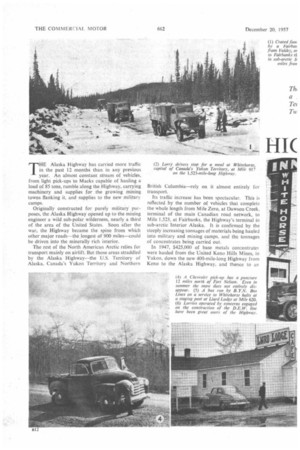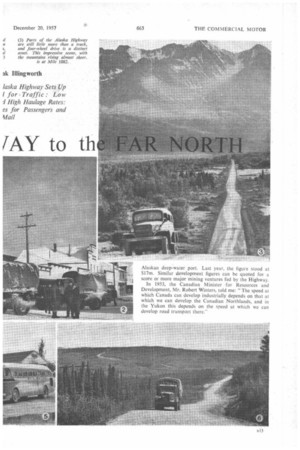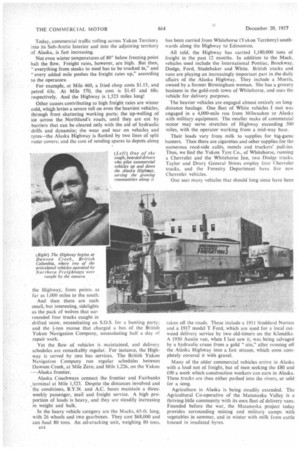HI(
Page 46

Page 47

Page 48

Page 49

If you've noticed an error in this article please click here to report it so we can fix it.
TAY to th
rik Ming worth
Thi a .
Ted laska Highway Sets Up for Traffic : Low i High Haulage Rates: es for Passengers and tvfaii
THE Alaska Highway has carried more traffic in the past 12 months than in any previous year. An almost constant stream of vehicles, from light pick-ups to Macks capable of hauling a load of 85 tons, rumble along the Highway, carrying machinery and supplies for the growing mining towns flanking it, and supplies to the new military camps.
Originally constructed for purely military purposes, the Alaska Highway opened up to the mining engineer a wild sub-polar wilderness, nearly a third of the area of the United States. Soon after the war, the Highway became the spine from which other major roads—the longest of 900 miles—could be driven into the minerally rich interior.
The rest of the North American Arctic relies for transport mainly on airlift. But those areas straddled by the Alaska Highway—the U.S. Territory of Alaska, Canada's Yukon Territory and Northern
British Columbia—rely on it almost entirely for transport.
Its traffic increase has been spectacular. This is reflected by the number of vehicles that complete the whole length from Mile Zero, at Dawson Creek. terminal of the main Canadian road network, to Mile 1,523, at Fairbanks, the Highway's terminal in sub-arctic Interior Alaska. It is confirmed by the steeply increasing tonnages of materials being hauled into military and mining camps, and the tonnages of concentrates being carried out.
In 1947, $425,000 of base metals concentrates were hauled from the United Keno Hills Mines, in Yukon, down the new 400-mile-long Highway from Keno to the Alaska Highway, and thence to ac
Alaskan deep-water port. Last year, the figure stood at Slim. Similar development figures can be quoted for a score or more major mining ventures fed by the Highway.
In 1953, the Canadian Minister for Resources and Development, Mr. Robert Winters, told me: "The speed at which Canada can develop industrially depends on that at which we can develop the Canadian Northlands, and in the Yukon this depends on the speed at which we can develop road transport there." Today, commercial traffic rolling across Yukon Territory into its Sub-Arctic Interior and into the adjoining territory of Alaska, is fast increasing.
Not even winter temperatures of 80° below freezing point halt the flow. Freight rates, however, are high. But then, "everything from steaks to steel has to be trucked in," and
every added mile pushes the freight rates up," according to the operators For example, at Mile 460, a fried chop costs $1.15, and petrol 63c. At Mile 570, the cost is $1.45 and 68c. respectively. And the Highway is 1,523 miles long!
Other causes contributing to high freight rates are winter cold, whiek levies a severe toll on even the heaviest vehicles, through frost shattering working parts; the up-welling of ice across the Northland's roads, until they are cut by barriers that can be cleared only with the aid of hydraulic drills and dynamite; the wear and tear on vehicles and tyres—the Alaska Highway is flanked by two lines of split outer covers; and the cost of sending spares to depots along the Highway, from points as far as 1.000 miles to the south.
And then there are such small, but interesting, sidelights as the pack of wolves that surrounded four trucks caught in drifted snow, necessitating an S.O.S. for a hunting party; and the 1-ton moose that charged a bus of the British Yukon Navigation Company, necessitating half a day of repair work.
Yet the flow of vehicles is maintained, and delivery schedules are remarkably regular. For instance, the Highway is served by two bus services. The British Yukon Navigation Company run regular schedules between Dawson Creek, at Mile Zero, and Mile 1,226, on the Yukon —Alaska frontier.
Alaska Coachways connect the frontier and Fairbanks terminal at Mile 1,523. Despite the distances involved and the conditions, B.Y.N. and A.C. buses maintain a threeweekly passenger, mail and freight service. A high proportion of loads is heavy, and they are steadily increasing in weight and bulk.
In the heavy vehicle category are the Macks, 65-ft. long, with 26 wheels and two gearboxes. They cost $68,000 and can .haul 80 tons. An oil-cracking unit, weighing 80 tons. a14 has been carried from Whitehorse (Yukon Territory) southwards along the Highway to Edmonton.
All told, the Highway has carried 1,180,000 tons of freight in the past 12 months. In addition to the Mack, vehicles used include the International Pontiac, Brockway, Dodge, Ford, Studebaker and White. British trucks and vans are playing an increasingly important part in the daily affairs of the Alaska Highway. They include a Morris, owned by a former Birmingham woman. She has a grocery business in the gold-rush town of Whitehorse, and uses the vehicle for delivery purposes.
The heavier vehicles are engaged almost entirely on longdistance haulage. One fleet of White vehicles I met was engaged in a 4,000-mile run. from Milwaukee to Alaska with military equipment. The smaller make of commercial motor may serve stretches of Highway exceeding 500 miles, with the operator working from a mid-way base.
Their loads vary from milk to supplies for big-game hunters. Then there are cigarettes and other supplies for the numerous road-side cafés, motets and truckers' pull-ins. Thus, we find the Yukon Tyre Co., of Whitehorse, running a Chevrolet and the Whitehorse Inn, two Dodge trucks. Taylor and Drury General Stores employ four Chevrolet trucks, and the Forestry Department have five new Chevrolet vehicles.
One sees many vehicles that should long since have been taken off the roads. These include a 1911 Stoddard Norton and a 1917 model T Ford, which are used for a local cut. wood delivery service by two old-timers on the Klondike. A 1930 Austin van, when I last saw it, was being salvaged by a hydraulic crane from a gold "site," after running off the Alaska Highway into a fast stream, which soon completely covered it with gravel.
Many of the older commercial vehicles arrive in Alaska with a load not of freight, but of men seeking the £80 and £90 a week which construction workers can earn in Alaska. These trucks are then either pushed into the rivers, or sold for a song.
Agriculture in Alaska is being steadily extended. The Agricultural Co-operative of the Matanuska Valley is a thriving little community with its own fleet of delivery vans. Founded before the war, the Matanuska project today provides surrounding mining and military camps with vegetables in summer, and in winter with milk from cattle housed in insulated byres. It also sends vegetables and milk—not in churns, but frozen in pans—to camps as far as 600 miles away. Return loads include cattle fodder, which is delivered to Fairbanks by ship from the United States. Rates for bulky commodities like hay are high. This was confirmed to me by Mr. Johnny Muska, proprietor of a drivers' pull-in and big-game hunters' "lodge." "Hay for the horses I keep to carry bear-hunting parties into the Interior costs me $100 a ton because of freight costs," he said. It is carried 550 miles. Next spring, the 1,000-mile road from Fairbanks to the polar coast of Arctic Canada will be re-surfaced. So will the 900-mile Canol Road, derelict since the war. It used to serve a pipeline from the oil fields of Arctic Canada to the Alaska Highway. Along these roads will roll all types of commercial vehicle. Meanwhile, the 3,000 miles of new road linking the Alaska Highway to the growing deep-water ports along the Alaskan coast are being so improved as to make high speeds practical next summer.




























































































